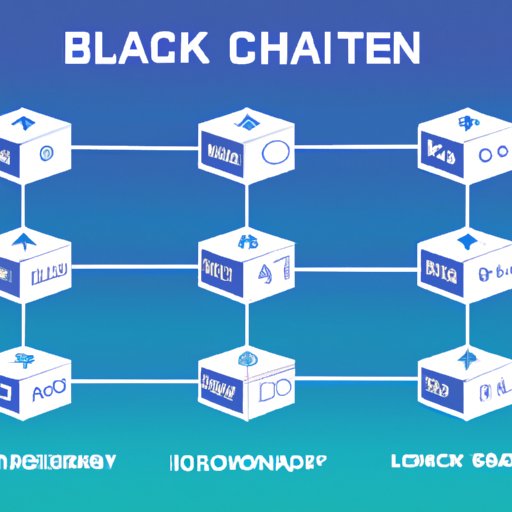Introduction
Blockchain technology has become increasingly popular in recent years. It is a digital ledger that records transactions between two or more parties securely and permanently. The data stored on a blockchain is immutable and transparent, making it a secure and reliable form of record-keeping. In this article, we will discuss what blockchain technology is, the components of a blockchain network, and how to build a blockchain from scratch.
Definition of Blockchain Technology
At its core, blockchain technology is a distributed ledger system. It is a decentralized system that stores information across multiple computers, so no single user can control or manipulate the data. This makes it difficult for hackers to break into the system, as all the data is spread out over a large number of computers. Additionally, all the data stored on a blockchain is encrypted, making it virtually impossible to alter or delete.

Overview of the Components of a Blockchain Network
A blockchain network consists of several key components: nodes, miners, and blocks. Nodes are computers that are connected to the network and store copies of the blockchain. Miners are responsible for verifying transactions and ensuring the integrity of the blockchain. Finally, blocks are records of transactions that are added to the blockchain. Each block contains a cryptographic hash of the previous block, a timestamp, and transaction data.
Building a Blockchain
Now that we understand the basics of blockchain technology, let’s discuss how to build one from scratch. Here is a step-by-step guide to creating a simple blockchain:
1. Create a Genesis Block: The first step is to create a genesis block, which is the first block in the chain. This is done by setting the previous block hash to 0 (or some other arbitrary value) and including a nonce, which is a random number used to generate the block hash.
2. Set Up a Network of Nodes: Next, you need to set up a network of nodes, which are computers connected to the blockchain. These nodes store copies of the blockchain and help validate transactions.
3. Create Blocks: Once the network is set up, you can start to create blocks. Blocks contain data about transactions, such as sender and receiver addresses, amounts, timestamps, etc. Each block also includes a cryptographic hash of the previous block.
4. Validate Transactions: When new transactions are received, they must be validated by miners. Miners use specialized software to solve cryptographic puzzles, which helps to ensure the integrity of the blockchain. If a miner successfully solves a puzzle, they are rewarded with cryptocurrency.
5. Add Blocks to the Chain: After a block is validated, it can be added to the chain. This process is known as “mining” and is essential for keeping the blockchain secure and up-to-date.
Benefits and Limitations of Using Blockchain Technology
Using blockchain technology offers several advantages, including increased security, transparency, and efficiency. All data stored on a blockchain is immutable, meaning it cannot be changed or deleted. This makes it difficult for hackers to access sensitive information. Additionally, all transactions are recorded on a public ledger, making them easily verifiable and transparent. Finally, blockchain technology can reduce costs and increase efficiency, as it eliminates the need for third-party intermediaries, such as banks and lawyers.
However, there are also some drawbacks to using blockchain technology. For example, it is still relatively new and untested, which means there could be unforeseen issues. Additionally, the scalability of blockchain technology is limited and it requires a lot of computing power, making it slow and expensive to run. Finally, the lack of regulation can lead to potential issues with privacy, fraud, and money laundering.
Existing Blockchain Platforms
If you don’t want to build your own blockchain from scratch, there are several existing blockchain platforms that you can use. Ethereum, Hyperledger Fabric, and Corda are some of the most popular blockchain platforms. They offer different features and capabilities, so it’s important to do your research before deciding which one to use.
Ethereum is an open-source blockchain platform that enables developers to create smart contracts and decentralized applications (DApps). It is a public blockchain, meaning anyone can view and participate in the network. Hyperledger Fabric is another popular platform, but it is a private blockchain, meaning only certain users have access to the network.
Corda is a distributed ledger platform designed specifically for enterprise use cases. It is a permissioned blockchain, meaning each node must be authorized by the network before it can join. Corda is also more scalable than other blockchain platforms, making it ideal for large-scale projects.
Conclusion
In conclusion, blockchain technology is a secure and reliable form of record-keeping. It offers many advantages, such as increased security, transparency, and efficiency. Building a blockchain from scratch can be a complex and time-consuming process, but there are several existing blockchain platforms that can help simplify the process. Understanding the benefits and limitations of using blockchain technology is essential for determining whether or not it is the right solution for your business.
We hope this article has provided you with a better understanding of how to make a blockchain. For more information on blockchain technology and existing blockchain platforms, we recommend doing further research.
(Note: Is this article not meeting your expectations? Do you have knowledge or insights to share? Unlock new opportunities and expand your reach by joining our authors team. Click Registration to join us and share your expertise with our readers.)
